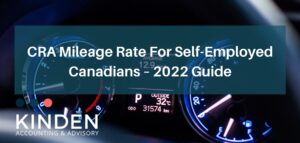Introduction
There are 4 key things to think about when talking about how work vehicles are taxed in Canada
- Employee-Owned Vehicles: The employee owns a vehicle they are using for work purposes
- Employer-Owned Vehicles: The employer owns the vehicle that the employee uses for work purposes
- Luxury Vehicles: Vehicles classified as luxury vehicles under the CRA rules
- Vehicle Allowances: Amounts an employer pays to an employee as compensation for using their vehicles
If you’re an employer or employee using Canadian vehicles for work, this article is for you. Today, we’re going to be diving into the details of how work vehicles are taxed in Canada.
Employee-Owned Vehicles
In the employee-owned case, the employee uses their own vehicle to do their job. The employee tracks the kilometers driven that were business-related. This is then used to calculate what percentage of the vehicle use was business related. The employee is sometimes permitted to deduct that percentage of the cost of owning and operating the vehicle.
The ability of an employee to deduct automobile-related operating expenses against employment income is based on three specific requirements under the income tax act:
- The person must be required to pay their own motor-vehicle costs, and must have form T2200, signed by the employer, which certifies this is the case;
- The person must be ordinarily required to perform employment-duties away from the employer’s place of business; and,
- The person must not be in receipt of an allowance for travel costs that was not included in income.
If all three of these criteria are met, an employee is permitted to deduct a portion of vehicle costs related to performing their work duties. Points 1 and 2 above are pretty straight forward. However, we will expand more on point 3 later when we talk about vehicle allowances.
Company Owned Vehicles
In the employer-owned case, if the employee uses the vehicle for personal reasons, a thing called a taxable benefit is included in their employment income. The taxable benefit can be broken into two separate benefits:
Stand-by Charge
The standby charge, which is intended to reflect the fixed cost of owning an automobile. Fixed costs are costs that you pay whether the vehicle is used or not. A good example is a lease payment or car loan payment. The calculation depends on whether a vehicle is leased or owned by the employer. In most cases, when the vehicle is owned, the taxable benefit to the employee is higher than when it is leased.
One thing to keep in mind is that if the employee makes payments to the employer for use of the vehicle, it can be offset against the amount of the stand-by charge.
Operating Cost Benefit
The operating cost benefit is intended to reflect the cost of operating a vehicle. You can think of this as repair and maintenance costs. This is based on a rate that the CRA determines, multiplied by the personal miles driven by the employee.
One thing to keep in mind is that even if the employee pays a portion of the operating costs of the vehicle, it cannot be offset against the operating cost benefit.
Luxury Vehicles
In Canadian tax, there is this concept of luxury vehicles that limits the amounts that can be deducted. Basically, the CRA doesn’t want people to abuse the fact that vehicles are deductible as incentive to purchase excessively expensive vehicles. There are a number of ways that the CRA has implemented policies to discourage the purchase of luxury vehicles, which we’ll talk about here.
Capital Cost Allowance on Purchased (Owned) Vehicles
There is this thing in tax called the Capital Cost Allowance [CCA]. This is really outside of the scope of what we’re talking about here but its a simple concept. You can think of it like depreciation. When you buy a car, it depreciates as time passes, which is tax deductible for a business.
The CRA limits the CCA deduction on vehicles at $30,000 plus HST/GST. So, to hammer the point home, if a business buys a vehicle for $45,000, it will only be permitted to deduct $30,000, with the remaining $15,000 being non-deductible.
Limits on the Interest Expenses
The CRA also puts limits on the amount of interest that can be deducted for a vehicle. When a vehicle is purchased, there are usually financing costs that come with buying it, such as interest on a car loan. The CRA limits the amount that can be deducted as interest on a luxury vehicle at approximately $300 per month.
Limits on Lease Payments
More limitations; the maximum lease amount per month for a passenger vehicle is $800 plus HST per month. If you’re clever, you’re probably thinking “hey – what if I extend the lease term to reduce the lease payment to $800 per month?”
Well, the CRA has thought of that, which is why they have this thing called the anti-avoidance formula. We won’t go too far into the details, but essentially it takes this into account so that even if you extend the lease period, you’ll still be limited on the amount you can deduct.
Taxable Benefit
Last but not least, when the vehicle is employer owned, the taxable benefit to the employee driving the luxury vehicle is not limited to the $30,000 or $800 amounts from above. In other words, the taxable benefit to the employee is based on the actual price of the car.
Allowances for Motor Vehicles
Is a Car Allowance Taxable in Canada?
It’s a real pain to have to calculate the taxable benefit to the employee when the employer owns the vehicle. It means the employer has to have the employee track the personal mileage to determine the automobile benefit, and adds more administration at the end of the year when generating T4s.
For this reason, many employers will go for a vehicle allowance and have employees use their own vehicle, and provide them with some form of compensation. When we talk about vehicle allowances paid from an employer to an employee, there are really two types; non-taxable and taxable vehicle allowances.
Non-Taxable Allowances
When a vehicle allowance is non-taxable, the allowance is not considered income. That’s great and everything, but what makes a vehicle allowance non-taxable?
It comes down to this whole concept of whether a vehicle allowance is considered “reasonable.” What makes an allowance “reasonable?” Well, the CRA considers a vehicle allowance reasonable when:
- The allowance is based on a per kilometer amount
- The per kilometer amount is less than or equal to the proscribed rate (the proscribed rate is a per kilometer amount determined by the CRA); and,
- The employee is not reimbursed for all or part of the expenses of using the vehicle.
So, if an employee uses their own vehicle for work purposes and is paid an allowance per kilometer that is below the proscribed CRA per kilometer rate, it is not considered taxable. That’s a good thing, right? Well, not necessarily.
Remember in the employee-owned vehicle section when we talked about the requirements for deducting motor vehicle expenses? The third item, “must not have received a vehicle allowance which was not included in income” means that if an employee receives a non-taxable vehicle allowance, motor vehicle costs are not deductible. Depending on how much it costs the employee to own and operate the vehicle, they may prefer to have a taxable allowance so they can deduct the costs against employment income.
Taxable Allowances
Taxable vehicle allowances are any vehicle allowance that does not meet the non-taxable vehicle allowance requirements. If the per kilometer amount exceeds the CRA proscribed amount, it is taxable. If the allowance is not based on kilometers, it is taxable. If the employee has received reimbursements for operating the vehicle, it is taxable.
I’ll take this opportunity again to point out that a taxable allowance is not necessarily bad because it means the employee can deduct motor vehicle costs, assuming they have met the other requirements laid out in the employee-owned section above.
Summary of vehicle taxes
So after reading all of this, you might be wondering what the “best way to do it” is. Generally speaking, having the employee use their own vehicle and then paying an allowance is the easiest from the employer and employee perspective. From the employer’s perspective, there is not a big difference between paying a taxable versus a non-taxable allowance.
From an employee’s perspective, it depends on how much it costs the employee to own and operate the vehicle. If the cost of operating the vehicle for work purposes exceeds the allowance amount, the employee would prefer that the allowance be taxable.
In some cases, employers will provide a vehicle, especially when it is specific to the employment duties. This is frequently seen in construction and service companies.
The way in which vehicles for work is structured has many variables and can have significant tax implications. We might be your best bet if you’re on the hunt for an Accounting firm in Halifax! We provide you with a deadly combination of professional, next-gen accountants, and impressive cloud technology – contact us today!



